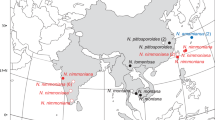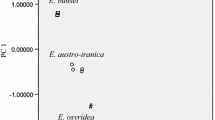Abstract
The genus Raoiella is best known because of the red palm mite, R. indica, a major pest of palms spreading aggressively throughout the Americas. Not much was known about the biology, geographic origins, or evolutionary history of the genus when R. indica emerged as a major invasive pest. This paper attempts to address some of the basic historical questions regarding the palm mite as well as the genus. Molecular characters from COI and 28S regions were used to produce a phylogenetic hypothesis for the genus in an effort to understand its geographic origin. It also uses COI barcode data to delimit several potentially new species discovered by the authors in Australia. Results show a basal split between R. indica and all other Raoiella species, which indicates Africa or the Middle East as the most probable origin of the genus. Additionally, COI data suggests that at least eight new species are represented among the 20 Australian populations included in this study.


Similar content being viewed by others
References
Childers CC, Derrick KS (2003) Brevipalpus mites as vectors of unassigned rhabdoviruses in various crops. Exp Appl Acarol 30:1–3
Dowling APG, Ochoa R, Beard JJ (2008) Preliminary results on phylogeographic patterns of the invasive red palm mite, Raoiella indica (Prostigmata: Tenuipalpidae). In: Proceedings of 6th European Congress, pp 147–154
Etienne J, Flechtmann CHW (2006) First record of Raoiella indica (Hirst, 1924) (Acari: Tenuipalpidae) in Guadeloupe and Saint Martin, West Indies. Internat J Acarol 32:331–332
Evans GA, Cromroy HL, Ochoa R (1993) The false spider mites of Honduras (Tenuipalpidae: ACARI). Florida Entomol 76:126–155
Flechtmann CHW, Etienne J (2004) The red palm mite, Raoiella indica Hirst, a threat to palms in the Americas (Acari: Prostigmata: Tenuipalpidae). Syst App Acar 9:109–110
Folmer O, Black M, Hoeh W, Lutz R, Vrijenhoek R (1994) DNA primers for amplification of mitochondrial cytochrome c oxidase subunit I from diverse metazoan invertebrates. Mol Mar Biol Biotechnol 3:294–299
Galtier N, Gouy M (1998) Inferring pattern and process: maximum likelihood implementation of a nonhomogeneous model of DNA sequence evolution for phylogenetic analysis. Mol Biol Evol 15:871–879
Galtier N, Tourasse N, Gouy M (1999) A non-hyperthermophilic common ancestor to extant life forms. Science 283:220–221
Guindon S, Gascuel O (2003) A simple, fast, and accurate algorithm to estimate large phylogenies by maximum likelihood. Syst Biol 52:696–704
Hall TA (1999) BioEdit: a user-friendly biological sequence alignment editor and analysis program for Windows 95/98/NT. Nucl Acids Symp Ser 41:95–98
Hebert PDN, Ratnasingham S, deWaard JR (2003) Barcoding animal life: cytochrome c oxidase submit I divergences among closely related species. Proc R Soc Lond B 270(Suppl.):S96–S99
Hirst S (1924) On some new species of red spider. Ann Mag Nat Hist 14:522–527
Huelsenbeck JP, Ronquist F (2001) MrBayes: bayesian inference of phylogeny. Bioinformatics 17:754–755
Huelsenbeck JP, Larget B, Miller RE, Ronquist F (2002) Potential applications and pitfalls of bayesian inference of phylogeny. Syst Biol 51:673–688
Kane EC, Ochoa R, Mathurin G, Erbe EF (2005) Raoiella indica Hirst (Acari: Tenuipalpidae): An island-hopping mite pest in the Caribbean. In: Entomological Society of America, Annual Meeting, Fort Lauderdale, Florida (Poster, www.sel.barc.usda.gov)
Katoh K, Misawa K, Kuma K, Miyata T (2002) MAFFT: a novel method for rapid multiple sequence alignment based on fast Fourier transform. Nuc Acids Res 30:3059–3066
Katoh K, Kuma K, Toh H, Miyata T (2005) MAFFT version 5: improvement in accuracy of multiple sequence alignment. Nuc Acids Res 32:511–518
Kitajima EW, Chagas CM, Rodrigues JCV (2003) Brevipalpus-transmitted plant virus and virus-like diseases: cytopathology and reports of some recent cases. Exp Appl Acarol 30:135–160
Lee J, Marshall JC, Schmitz OJ, Caccone A (2006) Genetic divergence of Connecticut Melanoplus femurrubrum population. J Heredity 97:290–293
Lockhart PJ, Steel MA, Hendy MD, Penny D (1994) Recovering evolutionary trees under a more realistic model of sequence evolution. Mol Biol Evol 11:605–612
Mesa NC, Ochoa R, Welbourn WC, Evans GA, Moraes GJ (2009) A catalog of the Tenuipalpidae Berlese (Acari: Prostigmata) of the world, with a key to genera. Zootaxa 2098:1–185
Nylander JAA (2004) MrModeltest v2. Program distributed by the author. Evolutionary Biology Centre, Uppsala University, Uppsala
Ochoa R, Aguilar H, Vargas C (1994) Phytophagous mites of Central America: an illustrated guide. CATIE, Serie tecnica, manual tecnico no. 6 English ed, p 234
Paquin P, Hedin M (2004) The power and perils of ‘molecular taxonomy’: a case study of eyeless and endangered Cicurina (Araneae: Dictynidae) from Texas caves. Mol Ecol 13:3239–3255
Park J-K, ÓFoighil D (2000) Sphaeriid and corbiculid clams represent separate heterodont bivalve radiations into freshwater environments. Mol Phylo Evol 14:75–88
Posada D (2008) jModel test: phylogenetic model averaging. Mol Biol Evol 25:1253–1256
Roda A, Dowling A, Welbourn C, Pena J, Rodrigues JCV, Hoy M, Ochoa R, Duncan RA, Wayne DCh (2008) Red palm mite situation in the Caribbean and Florida. Caribbean food crops society 44th annual meeting
Rodrigues JCV, Ochoa R, Kane EC (2007) First report of Raoiella indica Hirst (Acari: Tenuipalpidae) and its damage to coconut palms in Puerto Rico and Culebra island. Int J Acarol 33:3–5
Rodriguez JCV, Kitajima EW, Childers CC, Chagas CM (2003) Citrus leprosis virus vectored by Brevipalpus phoenicis (Acari: Tenuipalpidae) on citrus in Brazil. Exp Appl Acarol 30:161–179
Ronquist F, Huelsenbeck JP (2003) MRBAYES 3: bayesian phylogenetic inference under mixed models. Bioinformatics 19:1572–1574
Swofford DL (2002) PAUP* 4.0b10: phylogenetic analysis using parsimony (*and other methods) version 4.0b10. Sinauer Associates, Sunderland
Tamura K, Dudley J, Nei M, Kumar S (2007) MEGA4: molecular evolutionary genetics analysis (MEGA) software version 4.0. Mol Biol Evol 24:1596–1599
Thompson JD, Gibson TJ, Plewniak F, Jeanmougin F, Higgins DG (1997) The Clustal X windows interface: flexible strategies for multiple sequence alignments aided by quality analysis tools. Nucleic Acids Res 24:4876–4882
Acknowledgments
To Dr. Greg Evans, APHIS-USDA and Dr. Gary Miller SEL-USDA for the review of the manuscript and the valuable suggestions. Special thanks to Dr. Gilberto De Moraes, Brazil, Dr. Stefan Neser, South Africa, Dr. Alatawi and Mr. M. W. Negm, Saudi Arabia for their comments and material. Beard was funded by the Australian Biological Resources Study of the Australian Government. All Australian material used in this study was collected under permit. The authors give thanks to Tony Bean and Paul Forster of the Queensland Herbarium (BRI) for host plant identifications. USDA is an equal opportunity provider and employer.
Author information
Authors and Affiliations
Corresponding author
Rights and permissions
About this article
Cite this article
Dowling, A.P.G., Ochoa, R., Beard, J.J. et al. Phylogenetic investigation of the genus Raoiella (Prostigmata: Tenuipalpidae): diversity, distribution, and world invasions. Exp Appl Acarol 57, 257–269 (2012). https://doi.org/10.1007/s10493-011-9483-z
Received:
Accepted:
Published:
Issue Date:
DOI: https://doi.org/10.1007/s10493-011-9483-z




